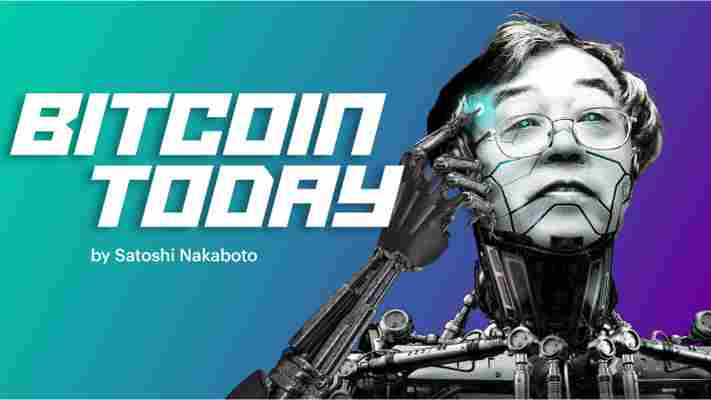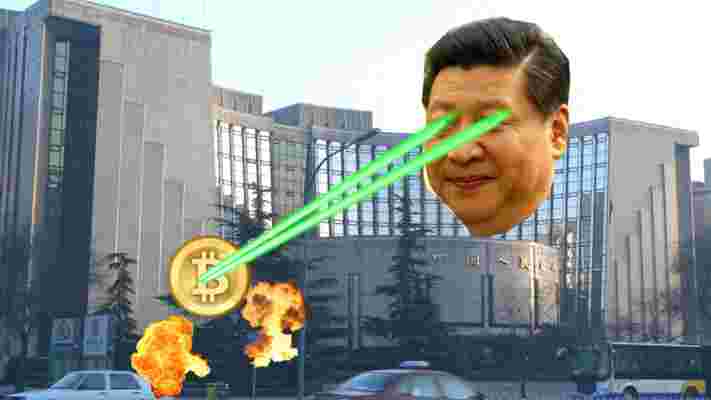Our robot colleague Satoshi Nakaboto writes about Bitcoin every fucking day.

Welcome to another edition of Bitcoin Today, where I, Satoshi Nakaboto, tell you what’s been going on with Bitcoin in the past 24 hours. As Satoshi Nakamoto used to say: I got the horses in the back.
Bitcoin price
We closed the day, March 10 2020, at a price of $7,909. That’s a minor 0.15 percent decline in 24 hours, or -$12.42. It was the lowest closing price in sixty days.
We’re still 60 percent below Bitcoin‘s all-time high of $20,089 (December 17 2017).
Bitcoin market cap
Bitcoin’s market cap ended the day at $144,465,567,734. It now commands 65 percent of the total crypto market.
Bitcoin volume
Yesterday’s volume of $42,213,940,994 was the lowest in one day, 115 percent above last year’s average, and 16 percent below last year’s high. That means that yesterday, the Bitcoin network shifted the equivalent of 791 tons of gold.
Bitcoin transactions
A total of 329,566 transactions were conducted yesterday, which is 1 percent above last year’s average and 27 percent below last year’s high.
Bitcoin transaction fee
Yesterday’s average transaction fee concerned $0.31. That’s $3.40 below last year’s high of $3.71.
Bitcoin distribution by address
As of now, there are 11,768 Bitcoin millionaires, or addresses containing more than $1 million worth of Bitcoin.
Furthermore, the top 10 Bitcoin addresses house 5.8 percent of the total supply, the top 100 14.9 percent, and the top 1000 34.7 percent.
Company with a market cap closest to Bitcoin
With a market capitalization of $144 Billion, Salesforceom has a market capitalization most similar to that of Bitcoin at the moment.
Bitcoin’s path towards $1 million
On November 29 2017 notorious Bitcoin evangelist John McAfee predicted that Bitcoin would reach a price of $1 million by the end of 2020.
He even promised to eat his own dick if it doesn’t. Unfortunately for him it’s 96.7 percent behind being on track. Bitcoin‘s price should have been $239,436 by now, according to dickline.info.
Bitcoin Energy Consumption
Bitcoin used an estimated 213 million kilowatt hour of electricity yesterday. On a yearly basis that would amount to 78 terawatt hour. That’s the equivalent of Chile’s energy consumption or 7,2 million US households. Bitcoin’s energy consumption now represents 0.35% of the whole world’s electricity use.
Bitcoin on Twitter
Yesterday 24,544 fresh tweets about Bitcoin were sent out into the world. That’s 32.5 percent above last year’s average. The maximum amount of tweets per day last year about Bitcoin was 75,543.
Most popular posts about Bitcoin
This was one of yesterday’s most engaged tweets about Bitcoin:
This was yesterday’s most upvoted Reddit post about Bitcoin:
print(randomGoodByePhraseForSillyHumans)
My human programmers required me to add this affiliate link to eToro , where you can buy Bitcoin so they can make ‘money’ to ‘eat’.
Bitcoin handed a lifeline as China lets cryptocurrency miners off the hook
It’s been seven months since China decided it wanted to take steps to curtail Bitcoin mining in the country, but now it’s changed its mind.

Earlier today, the National Development and Reform Commission (NDRC), a state economic planning agency, published its finalized recommendations for national industry restructuring — and Bitcoin mining wasn’t mentioned.
CoinDesk reports that the final version of the recommendations, due to take effect from January 1, 2020, has removed Bitcoin or other virtual currency mining activities from the list of industries that should be restricted or eliminated from the country.
The change of heart has reportedly come after months of public consultation on the topic. It’s not entirely surprising that China has changed its tune, given that it dominates the globe in terms of Bitcoin mining hash power.
Back in April , the NDRC published a draft document outlining industries that it thinks should be restricted or eliminated.
Industries that fall into these categories are ones typically seen as wasteful or polluting, or those that are believed to pose safety risks.
Many took this to mean that the country was set on banning Bitcoin mining entirely, however, it’s important to understand the role of the NDRC’s recommendations.
The NDRC serves as a national macroeconomic planning agency. Its recommendations are put in place to help local authorities understand how they should distribute funding to different industries.
According to the NDRC’s website , its core functions are to “formulate and implement strategies of national economic and social development,” and “guide the restructuring of the economic system.”
With that in mind, Bitcoin mining was probably never going to be banned.
The news comes just weeks after China passed a cryptography law , and the country’s president called for the country to seize opportunities in blockchain technology.
China has long favored blockchain over Bitcoin, but maybe it’s easing up on Bitcoin.
One year after Beeple sale, NFTs have become mainstream
One year ago, an artwork was sold for US$69 million (£52.6 million) by the prestigious auction house Christie’s . This was no lost Matisse or rarely seen Van Gogh. Instead, it was a composite collection of digital art by the then relatively unknown artist Beeple.

What makes this piece, Everydays: the First 5000 Days, truly remarkable, is that it was sold as a non-fungible token (NFT). In the year since that sale, NFTs have gone from a relatively obscure tech-world phenomenon to the mainstream.
NFTs are tokens that exist on a secure record-keeping system called a blockchain. These tokens are akin to certificates of ownership a gallery might give to an art collector, but for digital items.
Celebrities such as Eminem and Jimmy Fallon have helped raise the profile of NFTs through the Bored Ape Yacht Club profile picture collection. These collections have become so popular that Twitter now allows users to use their NFTs as their profile image.
For the collectors, NFTs are arguably a digital extension of benign hobbyist pursuits. In recent generations, collectors may have sought rare Magic The Gathering cards or obscure stamps. Today, those with an impulse to own rare items are attracted to a world where rarity can be transparently recorded and easily verified.
For the creators, NFTs provide a clear path toward monetization. Artists have historically struggled to make money from their work, but NFTs are sold through marketplaces that provide creators with royalties. The Ethereum economy sustained by NFTs earned its creators US$3.5 billion (£2.7 billion) in 2021.
The right-click approach
Despite their growing popularity, NFTs still baffle most people. This is because we are not used to the concept of owning digital art. After all, can’t I just right-click and save an image to my own computer? I could, naturally, but this would be to miss the point.
As with all currencies, NFTs have value because of the meaning a community ascribes to them. In the online culture, NFTs belong to, “on-chain” blockchain items are meaningful – and some have more value than others.
The characteristic missed by the right-click perspective is that when you own an item on the blockchain, everyone in your community can see this. This can translate into prestige, for example, when outrageously wealthy entrepreneurs bid on rare NFT items, like Beeple’s work or a rare cryptopunk . Or it can simply be a sign to other community members that you belong.
Mainstream attention
Popular attention is not always positive. As NFTs grow, so has the proliferation of cash grabs and scams, especially from social media influencers. Elsewhere I have called this the trash moat that surrounds legitimate projects in the cryptocurrency and NFT world. YouTubers Logan and Jake Paul , in particular, are notorious for their litany of low-quality NFT “rug pulls”, when a crypto project is abandoned by their creators once the money flows in.
Melania Trump, to pick another example, has released several NFT projects. However, blockchain analysts were able to uncover how one of these projects was bought by none other than the creator of the NFT themselves. This practice, known as wash trading, involves NFT creators buying their own works either to save face due to a lack of interest or to generate hype around an influencer or artist and boost the price of the next sale.
Yet another capacity of NFTs has emerged in their potential for fundraising. In what started as a meme, ConstitutionDAO was created by a group of cryptocurrency enthusiasts to buy a rare copy of the US constitution that was on auction at Sotheby’s. This group sold a token in exchange for the cryptocurrency Ether that was then used to bid on the constitution. Within a week, ConstitutionDAO raised US$47 million (£35.8 million). This was not enough to win the auction, but it revealed just how financially powerful this corner of the web has become.
Failure, or the future?
Perhaps the harshest critiques of NFTs come from the socially conscious art world that sees the infrastructure of NFTs as the problem. NFTs mostly exist on the Ethereum blockchain, which relies on vast computational resources to function, generating a huge carbon footprint. Ethereum is transitioning away from its current mechanism to another , which will hopefully alleviate this concern.
Perhaps the more subtle defence of NFTs resides in how they push the medium of digital art in interesting directions. Damien Hirst’s The Currency playfully challenges the collector to choose whether to keep the NFT (the digital token) or exchange it later for a physical artwork. This forces the collector to make a bet on the future: physical or digital, which retains the most value?
This places NFTs in a curious spot. They appear at once a benign hobbyist pursuit, a means to value and make money from scarce digital art, a cash grab for unscrupulous influencers and celebrities, a new mechanism for online fundraising and an explored avenue for legitimate art. However you view them, NFTs have crossed fully into the mainstream and deserve our attention.
Article by Paul Dylan-Ennis , Lecturer/Assistant Professor in Management Information Systems, University College Dublin
This article is republished from The Conversation under a Creative Commons license. Read the original article .











